Review for Ai Yori Aoshi: The Complete Series (Anime Classics)
Introduction
I got broadband in 2008, pretty much a latecomer to the whole thing. Day 1, I swore to myself that I wouldn’t be tempted by all the illicit anime online, all the fansubs and DVD rips. This was pre-Crunchyroll of course, and that vow lasted a whole of two weeks. So a perfect storm of try-before-you buy, streaming video, a little guilt, two dollars to the pound, and discovering Right Stuf.com meant that I was watching anime like never before, and getting all the good stuff on DVD, imported or otherwise. That perfect storm turned into a perfect tsunami a few months later, as the economy turned to crap, and anime distributors turned up their heels. I saw Ai Yori Aoshi, and immediately fell in love with it, only to find that its DVDs were already on the endangered list, and before Geneon could think about re-releasing it, they’d left the scene. Funimation picked up the show as soon as that happened, but it’s only been this year that they’ve finally released the show in one Classic Collection, which also includes the Ai Yori Aoshi ~Enishi~ sequel series which I have yet to watch. Good things do come to those who wait, and who’ve filled the intervening years by finding and reading the manga...
But what’s so good about Ai Yori Aoshi? It is after all a harem show, a romantic comedy that centres around a somewhat weak-willed male lead, who despite previous total failures with the opposite sex, somehow attracts a whole bunch of cuties to his side, and comedy occurs as all the girls compete for his attention. That is Love Hina down to a tee, and most people agree that show has dated terribly. The thing about Ai Yori Aoshi is that unlike other harem shows, its story actually has the relationships develop, and it’s not too shy in bringing across the source manga’s ribald nature, in an industry where broadcast standards tend to neuter such material. I’ve been looking forward to watching it again, and this time I get to watch it in glorious television, instead of a weedy, stuttery, out of sync, low-res video-stream.
All 24 episodes of Ai Yori Aoshi are presented across 4 discs from Funimation Entertainment, while a further 2 discs hold the 12 episodes of Ai Yori Aoshi ~Enishi~. There are also some extras as well.
Ai Yori Aoshi
Kaoru Hanabishi is the typical single college student, mildly offended at the constant onslaught of happy couples in the world, both in real life and in the relentless advertising. That’s mostly down to never having had a girlfriend, and his only solace is the college photography club. He’s almost forgotten his past life. Before he was disowned, he was heir to the Hanabishi group, and even betrothed to the heir of the Sakuraba group early in childhood as a means of unifying both businesses. It all comes flooding back when his fiancée comes looking for him, after fifteen years. Aoi Sakuraba has never forgotten Kaoru, and the promise they made, and she’s returned to make good on that promise. You’d think that with a cute girl like Aoi, Kaoru would have it made, but whereas a marriage between the Hanabishi and Sakuraba groups would have been acceptable, a marriage between Aoi and a no-name student is not. But seeing Aoi’s determination, her mother comes up with a compromise.
Aoi and Kaoru will get to spend some time together, but to avoid scandal they’ll have to do so under the pretence of a Landlord/Tenant relationship. They’ll live at one of the Sakuraba summer homes, with Aoi as the landlady, and Kaoru as the tenant living in the lodge outside. To keep things chaste, Aoi’s tutor/guardian Miyabi will be there as chaperone, and estate manager. You wouldn’t think that there would be much pretence involved, but then the other tenants move in, Kaoru’s upperclassman Tina Foster, and a first year student named Taeko who also takes work as a live in maid. Then another girl from Kaoru’s past named Mayu, who also thinks she’s engaged to him shows up, and then Taeko’s young cousin Chika moves in too.
And not only must Aoi and Kaoru keep their courtship secret from everyone, all of these girls turn out to be sweet on Kaoru as well...
Disc 1
1. Fate
2. Supper
3. Separation
4. Living Together
5. Old Friend
6. Family Tradition
Disc 2
7. Spiritual Illusion
8. Cherished Treasure
9. One Night
10. Place of Learning
11. Debutante
12. Kiss
Disc 3
13. Star Festival
14. Servant
15. Feelings of the Heart
16. Shores
17. Waves
18. Bedsharing
Disc 4
19. Lap Pillow
20. Cure
21. Influenza
22. Going Home
23. Determination
24. Aoi
Ai Yori Aoshi ~Enishi~
It’s been two years since Aoi and Kaoru were reunited, and came to their unconventional living arrangement. Kaoru is now a graduate student, and Chika is also a tenant as she goes to school in Tokyo, while Mayu may as well be, with all the time that she spends with Kaoru, Aoi, Tina, Tae, Miyabi and Chika. But after two years, is Aoi tiring of maintaining the fiction of landlady and tenant between her and Kaoru?
Disc 5
1. Spring Blossom
2. Friends
3. Tennis
4. Phantoms
5. Piano
6. Journey
7. Summer Resort
Disc 6
8. Fish and Water
9. White
10. Bathrobe
11. Moonlight
12. Bonds
Picture
Ai Yori Aoshi and its sequel get 4:3 regular transfers on these NTSC discs from Funimation. The image is clear and sharp throughout, with only moments of frenetic motion attracting compression artefacts. That really just boils down to the fast pan upwards over a field of flowers at the start of the opening sequence. Ai Yori Aoshi is ten years old now, and comes from a time when animators were transitioning from tradition cel animation to CG animated shows. This is an early one of those, and it shows in the rigidity of the animation (almost Flash-like), the strong primary colours, and the difficulty in making the characters fit into their backgrounds. All that said, it’s something that you quickly forget, and you’re pretty soon taking in the show on its own merits. The animation also improves for the sequel.
Sound
You have the choice between DD 2.0 English and Japanese stereo with optional subtitles and a signs only track. To be frank, the dub hasn’t aged well, and I was happier with the Japanese audio. The dialogue is clear throughout, and there are some nice stereo placement of effects and voices. Yoko Ishida’s opening theme for the first series is one of my favourite songs, and this isn’t a show where I skip the credits. The Japanese voices for the show also meet the clichés of an era past, and you certainly don’t hear too many characters like these in modern anime. That said, I love the voice performance for Taeko. The subtitles are free of error and accurately timed.
Extras
Six discs into a case that’s just one millimetre wider than a standard Amaray do go! It comes with a card slipcover that repeats the cover art and gives it an Anime Classics Border. The case itself is a little sturdier than the usual Amaray, with a little overlapping reinforcement. It has one disc on each face, and with two hinged panels, it holds all the other four discs in the middle, one on each facet of a panel. The inside of the sleeve has disc contents on one side and more artwork on the other. The discs have a very attractive purple art style, and all discs have jacket pictures that display when they aren’t at spin in compatible players.
Each disc also autoplays with Funimation trailers. Disc 1 plays Fractale, 2 plays Fullmetal Alchemist: Brotherhood, 3 plays Tales of Vesperia: First Strike, Disc 4 plays a trailer for Kaleido Star, 5 plays Okami-san and her Seven Companions, and 6 plays the trailer for Shakugan no Shana on Blu-ray.
Disc 4 has a fair few extras, mostly textless and original credit sequences. You get two versions of the opening where you can play spot the difference (there is one, honestly), two of the closing sequences, the original Japanese opening, and a short Yoko Ishida music video.
The big extra on this disc is the Bonus Episode: Speaking of Dreams, which is short at just four and a half minutes, but offers a bit of fun as the characters discuss what they wanted to grow up to be when they were little.
Disc 6 has the rest of the extras, beginning with a more substantial bonus episode in Miyuki. This lasts 16 minutes and is a prequel to the series, in which Kaoru gets a visit from a rather familiar looking Santa Claus one lonely Christmas night, and makes a special Christmas wish.
You’ll find Yoko Ishida – Live at AX ’04, a live stage performance where she sings the theme songs to the first series and the sequel. This lasts 9½ minutes.
You’ll also find the textless credits, one OP and two EDs, as well as Funimation trailers for Kaze no Stigma, Oblivion Island, and Hetalia World Series, as well as a promo for the Funimation.com web portal.
Conclusion
I guess it was something of a mistake to read the manga of Ai Yori Aoshi in between that first streaming and watching this DVD release. The manga story is complete for one thing; it doesn’t have to restrain itself to meet broadcast standards, and the story flows a lot better. The manga is preferable to the anime series, but it’s also very much out of print at this time, making the DVD the only convenient way to access the Ai Yori Aoshi story at this point. That isn’t to say that the series is bad, it’s certainly one of the best, if not the best harem shows out there (although many would claim it’s not a true harem as it establishes its central relationship directly from the off, and there’s no question as to who will end up with whom), and the strength of its storytelling does still stand strong. It’s just that it’s very much a show of its time, and in one or two aspects, it’s beginning to look decidedly dated.
What keeps it ahead of its peers though, and what makes it stand out and deserve the Anime Classics label that Funimation have applied to this release, is the central relationship between Kaoru and Aoi. In fact the show plays like a harem comedy sandwiched between a romantic drama, with the first four episodes devoted to setting up and developing Aoi and Kaoru’s relationship, and the final four episodes providing the hockey stick that threatens to trip up the love affair before it has a chance to blossom. Kaoru and Aoi were betrothed at a young age, both heirs to powerful financial families, and Kaoru made a distinct impression on the young Aoi, to the point where she devoted herself to him and the promise they share after he became absent from her life.
On the other hand, while Kaoru found happiness with Aoi, his position as heir to the Hanabishi family was less than pleasant, and the treatment of him and his mother by the Hanabishis left a negative impression on him to the point where he grew to hate them, and walked out on them as soon as he was old enough to live independently. That’s where we find him at the start of the series, in solitude, weighed down by his past, but trying to make the best of things. It’s something of a mixed blessing when Aoi re-enters his life bringing the prospect of no longer being alone, but also being dragged back into the complicated lives of the rich and powerful. While he does find happiness with Aoi, he’s also burdened by the dark past that tainted his childhood, and that balance adds some poignancy and drama to the romantic comedy hijinks.
It’s because he’s been disowned by the Hanabishi that he can’t simply follow through on the betrothal, but seeing Aoi’s devotion to him, her family decide to give the couple a chance. They have to avoid a scandal though, which engenders the fiction of Aoi becoming Kaoru’s landlord, aided by her guardian. To further the fiction, Kaoru has to live in a lodge outside, separate from Aoi. It’s here that the harem aspects of the series present themselves, as what seems like a simple fiction becomes more complicated as two of Kaoru’s classmates from college move in, Tina Foster and Taeko. As the series progresses, Taeko’s cousin Chika shows up, as does a girl from Kaoru’s past named Mayu. All of them become sweet on Kaoru, but because he has to keep his relationship with Aoi secret, there’s no simple way to tell them that he’s spoken for. And the harem comedy ensues.
The final four episodes restore the drama when it becomes clear that Aoi’s father isn’t as accepting of the situation as her mother. He still feels betrayed by the dissolution of the betrothal with the Hanabishi after Kaoru left them, he isn’t at all happy with the idea of his daughter marrying a comparative nobody, and when the offer comes to join his family with another wealthy dynasty through marriage, he decides that it’s time for the nonsense to end. It’s the stumbling block that threatens their happiness, and a nice bit of drama to end the first series on.
The sequel series isn’t quite as involving as the first, after all the emotional drama of the first series has been mostly dealt with. It’s back to the harem antics for the most part, with some original stories that focus more on the side characters than the main pair. It’s fun and ephemeral, but it’s not until the final four episodes of Enishi that the story looks to the manga once more for inspiration. There’s really only the one episode that moves the Aoi Kaoru relationship forward, although you get the feeling that the couple haven’t really moved forward at all in the intervening two years between the series. The final three episode arc concentrates on Tina, and once again echoes a manga storyline, but it’s a narrative weak point to end the series on, even if the characters are just as appealing and engaging as ever. Really Enishi is a bonus to people that fell in love with the first series, and feels for the most part like a collection of OVAs rather than a continuation. Speaking of OVAs, the Miyuki OVA in Enishi is the strongest part of that series, and its brief fifteen minutes are worth its inclusion alone, as it best pays homage to the first series and the manga storyline.
The weak points of this series are twofold. The first is that like so many other shows, it doesn’t quite do justice to the manga, not least in that the manga is complete. The anime leaves the story hanging, although at least it does do so at a point that offers some closure. It’s a happily ever after if that does mean an eternity living together in student dorm harmony, forever keeping secrets. The second weak point is that Ai Yori Aoshi is showing its age, and doing so in the characterisations. Aoi and Kaoru are written as pretty believable and rounded characters, but it’s the supporting cast, the members of the harem that are much more stereotypical and simplistic.
Tina Foster is the biggest culprit, reinforcing Japanese stereotypes of crass and overbearing Americans. Tina is loud, obnoxious, likes to drink, and greets other women by groping their breasts. Taeko is the terminally clumsy maid, big breasted (groping target), and liable to end up head over heels, skirt over her head, panties on show. She has some dimension in that she likes a good gossip, and is playfully sly at times. Her cousin Chika on the other hand provides the cute innocence (although her Japanese voice actress prefacing any line with a “Tee Hee Hee” got on even my nerves). Mayu is the tsundere brat, harsh abrasive society princess who treats everyone like dirt, except Kaoru who she adores. These are simple and subsequently very common clichés which after this much time do Ai Yori Aoshi few favours. It’s to its credit though that given enough time, it does develop these characters enough to make them likeable despite these drawbacks. You have to give it a lot of leeway though.
Still there is something to be said for simplicity of characterisation and stereotypes. It provides a shorthand and some comforting touchstones in relating to the characters. During the lighter episodes of the show, it’s easy just to stick a disc in and go with the flow, enjoy the gentle comedy, the odd awkward situations, and the refreshingly bawdy approach to the animation. This is a show which if made today would obscure anything vaguely offensive behind lens flare and hot springs mist. Ai Yori Aoshi at least doesn’t go that far, although it is tamer than the manga. A little acceptance of reality is refreshing in anime, rather than the animated equivalent of the L-shaped sheet protecting our 'oh so vulnerable' sensibilities. What makes Ai Yori Aoshi stand out from other harem shows is that it has heart. It makes you care for, and root for the central characters. It has a coherent story that it wants to tell, and it manages that with aplomb. It is these things which give it a timeless classic quality, despite its odd failing, and that makes it a show that ought to be on everyone’s shelf.
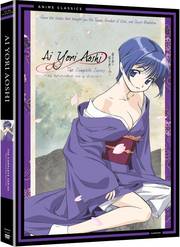
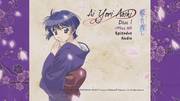




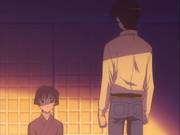
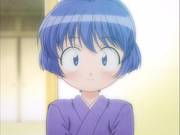

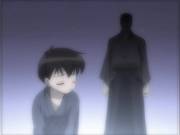
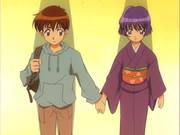







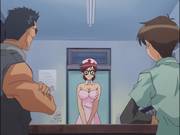
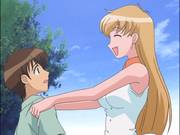










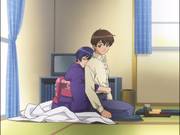
















































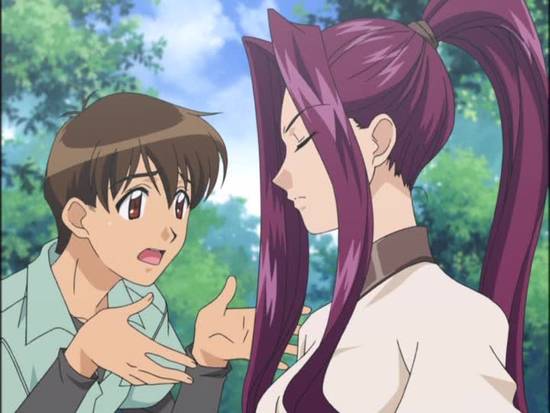




Your Opinions and Comments
Be the first to post a comment!